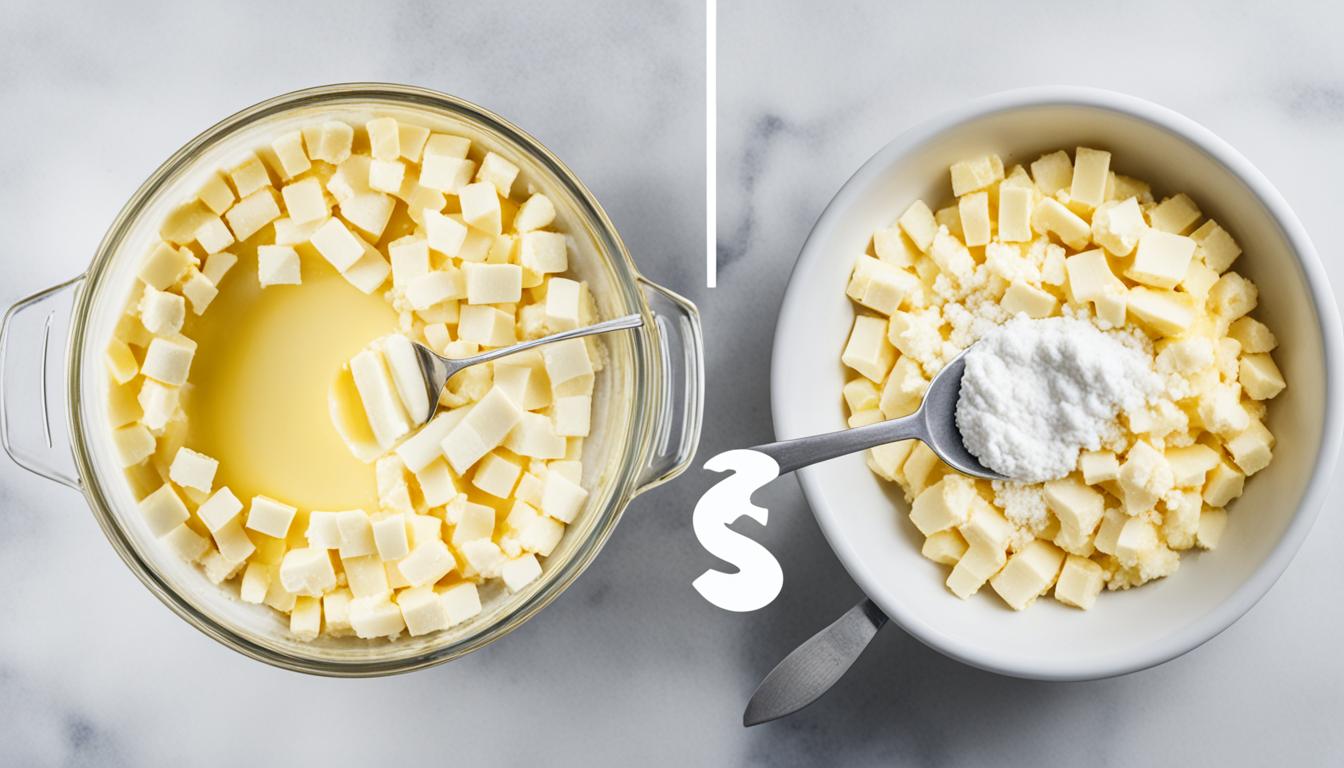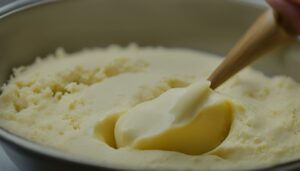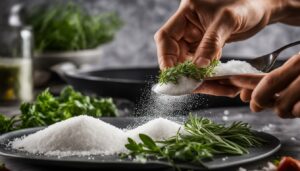Did you know that using the wrong type of butter in your baking can significantly impact the flavor and texture of your dishes? In fact, many baking recipes specifically call for unsalted butter for better control over the salt content. But what do you do if you only have salted butter on hand?
In this article, we will explore the differences between salted and unsalted butter, and provide you with valuable tips and tricks for substituting one for the other in your recipes. Whether you’re a novice baker or an experienced home cook, having a good understanding of salted and unsalted butter and knowing when and how to make substitutions can elevate your culinary creations to new heights.
Contents
- 1 The Difference Between Salted and Unsalted Butter
- 2 Why Do Baking Recipes Call for Unsalted Butter?
- 3 When to Use Salted or Unsalted Butter
- 4 How to Substitute Butter in Recipes
- 5 The Impact of Salted Butter on Baked Goods
- 6 The Freshness and Shelf Life of Salted vs. Unsalted Butter
- 7 Personal Preference and Experimentation
- 8 Conclusion
- 9 FAQ
- 9.1 Can I use salted butter if the recipe calls for unsalted?
- 9.2 What is the difference between salted and unsalted butter?
- 9.3 Why do baking recipes call for unsalted butter?
- 9.4 When should I use salted or unsalted butter?
- 9.5 How do I substitute butter in recipes?
- 9.6 What is the impact of using salted butter in baked goods?
- 9.7 Does salted butter have a longer shelf life than unsalted butter?
- 9.8 What should I consider when choosing between salted and unsalted butter?
- 9.9 What should I keep in mind when using salted vs. unsalted butter in baking?
- 10 Source Links
Key Takeaways
- Using the wrong type of butter can affect the flavor and texture of your baked goods.
- Many baking recipes call for unsalted butter to allow for better control over the salt content.
- If a recipe calls for unsalted butter and all you have is salted butter, you can make the substitution by adjusting the added salt.
- Understanding the differences between salted and unsalted butter is crucial for making informed decisions in the kitchen.
- Experimentation and personal preference play a role in determining the type of butter that suits your taste and baking needs.
The Difference Between Salted and Unsalted Butter
When it comes to baking, understanding the difference between salted and unsalted butter is essential. The main distinction lies in the presence of salt. Salted butter contains salt, while unsalted butter does not. This simple difference can significantly impact the flavor and texture of your baked goods.
One important factor to note is that the salt content in salted butter can vary between brands. This variability makes salted butter less predictable to work with in baking recipes. The amount of salt can affect the overall taste and can be challenging to control if a recipe does not specify the type of butter to use.
On the other hand, unsalted butter is frequently considered fresher compared to salted butter. Additionally, unsalted butter usually has a lower water content, which can influence the texture of your baked goods. The lower water content in unsalted butter can result in fluffier and crisper treats that hold their shape better over time.
Knowing these differences between salted and unsalted butter is crucial in making informed decisions when substituting one type for the other in your recipes. Whether you’re baking with salted butter or looking to use salted butter in your cooking, understanding the impact of these subtle differences will help you achieve the desired results.
Comparison of Salted and Unsalted Butter
| Factors | Salted Butter | Unsalted Butter |
|---|---|---|
| Salt Content | Contains salt | No salt |
| Variability | Varies between brands | N/A |
| Freshness | Can be preserved longer due to the presence of salt | Often fresher |
| Water Content | May have a slightly higher water content | Often lower water content |
Why Do Baking Recipes Call for Unsalted Butter?
Many baking recipes call for unsalted butter because it allows the baker to have full control over the flavor of their baked goods. The amount of salt in salted butter can vary between brands, making it difficult to accurately determine the saltiness of the final product. By using unsalted butter, bakers can easily control the salt content and ensure consistent results. Additionally, the lower water content in unsalted butter can help create fluffier, crisper baked goods that hold their shape better over time.
When to Use Salted or Unsalted Butter

Knowing when to use salted or unsalted butter in your recipes is essential for achieving the desired flavor and texture. If a recipe specifically calls for unsalted butter, it is best to use unsalted butter to maintain control over the salt content. However, if a recipe does not specify the type of butter, you can use salted butter as a substitute, but it is important to adjust the added salt accordingly.
For every 1/2 cup (1 stick) of salted butter used, reduce the added salt by 1/4 teaspoon.
Likewise, if a recipe calls for salted butter and you only have unsalted butter, add 1/4 teaspoon of salt for each stick of unsalted butter used. These substitutions can help ensure that your baked goods turn out as intended.
Examples:
Scenario 1: The recipe calls for unsalted butter.
Solution: Use unsalted butter to maintain control over the salt content and follow the recipe as directed.
Scenario 2: The recipe does not specify the type of butter.
Solution: If using salted butter, reduce the added salt by 1/4 teaspoon for every 1/2 cup of butter used. If using unsalted butter in a recipe that calls for salted butter, add 1/4 teaspoon of salt for each stick of unsalted butter used.
Salted vs. Unsalted Butter Substitutions
| Scenario | Type of Butter Needed | Adjustment |
|---|---|---|
| Recipe calls for unsalted butter | Unsalted butter | N/A |
| Recipe does not specify the type of butter | Salted butter | Reduce added salt by 1/4 teaspoon for every 1/2 cup of butter used |
| Recipe calls for salted butter | Unsalted butter | Add 1/4 teaspoon of salt for each stick of unsalted butter used |
How to Substitute Butter in Recipes
If you find yourself in a situation where you need to substitute one type of butter for another, there are a few guidelines to follow.
Substituting Salted Butter for Unsalted Butter:
If your recipe calls for unsalted butter but all you have is salted butter, you can make a successful substitution. Use the same amount of salted butter as the recipe requires, but remember to reduce the added salt by 1/4 teaspoon for every 1/2 cup of butter used. This adjustment helps maintain the desired saltiness of the recipe despite the higher salt content in the salted butter.
Substituting Unsalted Butter for Salted Butter:
If your recipe calls for salted butter but you only have unsalted butter, you can still achieve the desired flavor by adding salt. For each stick of unsalted butter used, add 1/4 teaspoon of salt. This compensates for the lower salt content in unsalted butter and ensures that the dish retains its intended taste.
By following these simple guidelines, you can confidently substitute butter in your recipes without compromising the flavor and texture of your dishes.
| Type of Butter | Substitution |
|---|---|
| Salted Butter | Use the same amount as the recipe requires, but reduce added salt by 1/4 teaspoon for every 1/2 cup of butter used. |
| Unsalted Butter | Add 1/4 teaspoon of salt for each stick of unsalted butter used. |
The Impact of Salted Butter on Baked Goods

Using salted butter in baking recipes can have a noticeable impact on the flavor and texture of the final product. The saltiness of the butter can enhance or overpower other flavors in the recipe, adding a savory element to sweet treats. However, it’s important to note that the salt content in salted butter can vary between brands, making it more challenging to control the overall saltiness of your baked goods.
If a recipe calls for unsalted butter and all you have is salted butter, you may be wondering if you can use it as a substitution. The short answer is yes, you can use salted butter instead of unsalted butter in your recipes. However, there are a few things to keep in mind when making this substitution.
Firstly, since salted butter already contains salt, you’ll need to adjust the amount of additional salt called for in the recipe. It’s essential to taste the batter or dough as you go and make adjustments accordingly. Adding too much salt can make your baked goods too salty, so it’s better to start with less and gradually add more if needed.
Furthermore, the flavor profile of the final product may be slightly different when using salted butter. The saltiness can add complexity and depth of flavor, which may be desirable in certain recipes, such as cookies or pie crusts. However, for delicate desserts where the flavors are more subtle, like a sponge cake or a custard, using unsalted butter might be a better option to allow the other ingredients to shine.
“When using salted butter, it’s important to be mindful of the salt content and adjust the recipe accordingly. Taste the batter or dough as you go and make any necessary flavor adjustments.”
Overall, the decision to use salted butter as a substitution for unsalted butter ultimately comes down to personal preference and the specific recipe you’re making. It’s always a good idea to experiment and see how the salted butter affects the flavor and texture of your baked goods. Remember, baking is as much a science as it is an art, so don’t be afraid to get creative and explore different variations to find the perfect balance of saltiness for your taste buds.
| Baked Goods | Salted Butter Recommendation | Unsalted Butter Recommendation |
|---|---|---|
| Cookies | Can enhance the flavor and add a subtle savory note. | Allows other flavors to shine and provides better control over the overall saltiness. |
| Pie Crusts | Can add a richness and depth of flavor. | Preserves the delicate and buttery flavor of the crust. |
| Cakes | May give a unique twist and complexity to the overall flavor. | Keeps the flavors more straightforward and allows other ingredients to be the star. |
| Pastries | Can contribute to a well-rounded taste and slight saltiness. | Helps maintain a delicate and subtle sweetness. |
The Freshness and Shelf Life of Salted vs. Unsalted Butter

When it comes to choosing between salted and unsalted butter, considering their freshness and shelf life is essential. Salted butter generally has a longer shelf life compared to unsalted butter due to the preservative properties of salt. While unsalted butter may be fresher when purchased, the presence of salt in salted butter helps extend its shelf life by up to 4 months.
Whether you’re baking with salted butter or using it in cooking, understanding the impact of shelf life on your dishes is important. The freshness of ingredients often translates to better-tasting results, making it crucial to select the right type of butter for your recipes.
Why does salted butter have a longer shelf life?
The preservation qualities of salt make salted butter less susceptible to spoilage and bacterial growth. The salt acts as a natural preservative by drawing out moisture, creating an environment that inhibits the growth of bacteria. This extended shelf life can be especially beneficial if you often find yourself with butter that needs to last longer.
Whether you prefer the convenience of having longer-lasting butter or the freshness of unsalted butter, understanding their differences can help you make informed choices in your baking and cooking endeavors.
| Butter Type | Shelf Life |
|---|---|
| Salted Butter | Up to 4 months longer than unsalted butter |
| Unsalted Butter | Shorter shelf life compared to salted butter, typically around 1-2 months |
As you can see, if you prioritize freshness, you may opt for unsalted butter. However, if you frequently find yourself needing butter that lasts longer, salted butter can be a practical choice.
Remember to store your butter properly to maximize its shelf life. Keep it refrigerated in an airtight container to prevent it from absorbing odors and to maintain its quality over time.
Next, we’ll explore personal preferences and experimentation when it comes to using salted or unsalted butter in your recipes.
Personal Preference and Experimentation

When it comes to choosing between salted and unsalted butter for your recipes, personal preference plays a significant role. Some cooks and bakers may prefer the added saltiness and longer shelf life of salted butter. On the other hand, others may lean towards the control and freshness offered by unsalted butter.
To determine which type of butter best suits your taste and baking needs, it can be helpful to conduct taste tests or experiments using different recipes. Try using salted butter in one batch and unsalted butter in another, and see how the flavors and textures differ. Everyone’s taste buds are unique, so experimenting and discovering your own preferences can make a big difference in the dishes you create.
Healthy alternatives to butter can also be explored during these experiments. You might find that using alternative spreads or oils can provide similar results or even add unique flavors to your recipes.
“Experimentation is the key to culinary discovery. By trying different ingredients and methods, you’ll develop a deep understanding of your own palate and cooking style.”
Ultimately, the choice between salted and unsalted butter is a matter of personal preference. Through experimentation and tasting, you can confidently make informed decisions when substituting one type of butter for another in your recipes.
Remember, there’s no right or wrong answer when it comes to your personal butter preference. What matters most is that you enjoy the delicious results of your culinary creations!
Conclusion
When it comes to baking with salted vs. unsalted butter, it’s important to consider a few key factors. While many recipes call for unsalted butter to have better control over flavor and texture, you can still substitute salted butter if necessary. Just remember to adjust the added salt accordingly to achieve the desired taste. Whether you use salted or unsalted butter ultimately depends on personal preference and experimentation.
Understanding the differences between these two types of butter is essential for becoming a more versatile and confident baker in the kitchen. While unsalted butter offers more control over the salt content and may result in fluffier, crisper baked goods, salted butter can add a subtle saltiness and extend the shelf life of your creations. It’s up to you to find the perfect balance and discover the flavor profile that matches your preferences.
So, the next time you come across a recipe that calls for unsalted butter but only have salted butter on hand, don’t worry! With the knowledge and understanding gained from this guide, you can confidently make the necessary adjustments and still achieve delicious results. Happy baking!
FAQ
Can I use salted butter if the recipe calls for unsalted?
Yes, you can use salted butter as a substitute for unsalted butter in recipes. However, you need to adjust the added salt accordingly. Reduce the added salt by 1/4 teaspoon for every 1/2 cup of salted butter used.
What is the difference between salted and unsalted butter?
The main difference is the presence of salt. Salted butter contains salt, while unsalted butter does not. Salted butter can have varying levels of salt, making it less predictable for baking.
Why do baking recipes call for unsalted butter?
Baking recipes call for unsalted butter because it allows for better control over the salt content in the final dish. This ensures consistent results and allows the flavors of other ingredients to shine.
When should I use salted or unsalted butter?
If a recipe specifically calls for unsalted butter, it is best to use unsalted butter to maintain control over the salt content. If a recipe does not specify, you can use salted butter but reduce the added salt accordingly. Add 1/4 teaspoon of salt for each stick of unsalted butter used.
How do I substitute butter in recipes?
When substituting salted butter for unsalted butter, use the same amount but reduce the added salt by 1/4 teaspoon for every 1/2 cup of butter. When substituting unsalted butter for salted butter, add 1/4 teaspoon of salt for each stick of unsalted butter used.
What is the impact of using salted butter in baked goods?
Salted butter can enhance or overpower the flavors in the recipe. The amount of added salt may need to be adjusted to prevent the dish from becoming too salty.
Does salted butter have a longer shelf life than unsalted butter?
Yes, salted butter generally has a longer shelf life compared to unsalted butter because the salt acts as a preservative. However, the freshness of the butter when purchased can also affect the flavor of the baked goods.
What should I consider when choosing between salted and unsalted butter?
The choice between salted and unsalted butter ultimately depends on personal preference. Conducting taste tests or experiments with different recipes can help you determine which type of butter suits your taste and baking needs.
What should I keep in mind when using salted vs. unsalted butter in baking?
When baking, it is important to consider the salt content and adjust the added salt accordingly. Understanding the differences between the two types of butter and following proper substitution guidelines can help you achieve delicious results.









